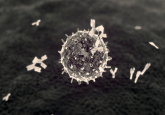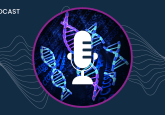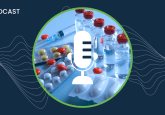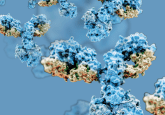The new frontier: assessing efficacy and safety of CGTs using biomarkers
In the sixth episode of The new frontier podcast, we’re joined by Catherine Vrentas, Life Sciences Lead Associate at Booz Allen Hamilton (VA, USA). Cathy explains how biomarkers can be used to predict the therapeutic outcome and efficacy of cell and gene therapies (CGTs) and the biomarkers in particular that have shown strong predictive value. We delve into the common challenges of working with biomarkers in CGTs and how biomarker kits can be adapted for CGT work.
Podcast transcript
[00:01] Ellen Williams: Hello, and welcome to the 6th and final episode of the Bioanalysis Zone podcast on cell and gene therapies (CGTs), sponsored by QPS Holdings. I’m your host, Ellen Williams, and today I’m joined by Catherine Vrentas, Life Sciences lead at Booz Allen Hamilton. Thank you very much for joining me, Cathy.
[00:27] Catherine Vrentas: Thank you so much, Ellen. I’m really happy to be here speaking with you.
[00:30] Ellen Williams: You’re very welcome. So for those who might be unfamiliar with your work, you are a subject matter expert in CGTs and large molecule biotherapeutics. In particular, your work is focused on bioanalytical method development, validation and sample analysis to support clinical trials. So, can you tell us a little bit more about your career to date?
[00:50] Catherine Vrentas: Absolutely. So, I came into bioanalysis actually a little bit into my career. I started with a very academic background, so working on protein purification, and then I moved into infectious disease for a while. So, I was looking at diseases of wildlife and livestock as a scientist, but I was always really interested and drawn towards applied science, and that really made bioanalysis a fit for me. And so I moved into bioanalysis specifically approximately 6 years ago and my focus was in immunoassay method development and validation. When I was there, I really quickly found my interest in rare diseases. I was really passionate about understanding how to develop assays for these applications and understanding the scientific background behind things like lysosomal storage disorders. So, I’ve been involved in that for a while. Some of the initiatives that I’ve worked on include a White Paper to understand how to use enzymatic assays for bioanalysis and also some collaborative studies for reference materials for immunogenicity. Very recently I’ve moved to a new role in the government consulting space and for this role, I support a large portfolio of pre-clinical programs as a CGT subject matter expert.
[02:10] Ellen Williams: Brilliant. Thank you very much for that. So, we’re going to chat to you today mostly about biomarkers within the CGT space. So, my first question is how can biomarkers be used to predict the therapeutic outcome or efficacy of CGTs, and which biomarkers in particular have shown strong predictive value?
[02:29] Catherine Vrentas: So to start this, I wanted to think a little bit about how we define a biomarker, right? So many of us work on biomarkers, etc., so I took a minute to look up the definition from the Biomarker Definitions Working Group and I think it’s a nice one. Their definition of a biomarker is a characteristic that is objectively measured and evaluated as an indicator of normal biological processes, pathogenic processes or pharmacologic responses to a therapeutic intervention. So when you think about biomarkers for CGT programs, there’s going to be different contexts of use (COU) and measuring different responses by the body. So, I’ll give you one example to start with. You might want to measure the level and/or the enzymatic activity of an enzyme. Let’s say someone has a monogenic enzyme disorder, and they’re deficient in producing a particular enzyme, so you might want to know what level of that protein is being made before or after therapy, and what is enzymatic activity before or after therapy.
[03:28] Another good example would be, let’s say, that enzyme is involved in breaking down a particular substrate, and if you don’t have it, there’s going to be some intermediate left or some sort of metabolic product. So, you might want to measure the level of that product, right? So how much of that product is present, and does it increase or decrease depending on the therapy? So those are a few examples.
[03:50] So I think there has been some really good examples in the news recently of how some of these biomarkers can be important in efficacy, and I’ll give a few examples. So if you think about gene therapy trials, right? So, you’re going to have small patient numbers generally. You’re not going to be having this large-scale randomized clinical trial. So, it may be particularly important to use biomarkers to understand the efficacy of the treatment.
[04:15] One area that’s particularly interesting is the use of biomarkers as surrogate endpoints. So in other words, if you have a clinical trial, can you use these measurements to predict if there’s a likely clinical benefit of your therapeutic? So actually this summer, there was a good example from Ultragenyx (CA, USA) in the news. So in their FDA submission, they were working on Sanfilippo syndrome, so this is a fatal lysosomal storage disease. They were proposing that you can use the level of heparin sulfate as a biomarker. So, you measure heparin sulfate in cerebrospinal fluid, and they were able to show that this correlates. So if you have a drop in this biomarker, that correlated with an increase in cognitive function in the patient, so, they argue that this could be used as a surrogate biomarker for accelerated drug approval. Now, of course, when you have these types of biomarkers, to really show that it’s linked to that clinical effect, that requires a lot of data. So, I think it’s worth noting that there’s a range of COU, like I said before. So some biomarkers might be used for more exploratory understanding of the effects.
[05:18] I think another good example recently was in the measurement of microdystrophin. So that was the biomarker that was used to look at patients with Duchenne muscular dystrophy, and that was in Sarepta’s (MA, USA) new gene therapy. When you’re thinking about all these, you know, it’s going to depend a lot. You mentioned which are most useful. It’s really going to depend a lot [on] the specific disease application. There’ll be many very disease-specific biomarkers, but I do think also there’s a lot of interest in finding some more generalizable measurements.
[05:48] So I think there’s a few good examples, and I think it’s really important for all of these types of bioanalytical programs for biomarkers to really understand the science of the disease. So, you need to understand the biochemistry of the proteins, what are the changes you are expecting? If, let’s say, a protein is missing in the disease, what types of other metabolic changes are going to be present, and that’s going to help you understand what biomarkers might be important. And as I said, it could be a variety of things, right? Not just maybe this direct protein that is implicated in the disease, but the levels of other proteins or the levels of other molecular measurements, right? So, there’s a real diversity in the types of markers that you can be assessing.
[06:30] Ellen Williams: Some really nice examples from recent news there as well. It’s something that’s coming up a lot within the CGTs. So, yes, thank you very much for that. So my second question then, what are maybe some of the common challenges that you’ve come across when working with biomarkers in CGT?
[06:46] Catherine Vrentas: I think one thing that really comes up is thinking about critical reagents. So if we’re talking about measuring pharmacokinetics (PK) of a monoclonal antibody drug, we have the drug, that’s the critical reagent. Sure, we need to develop specific antibodies to measure it, but for biomarkers, it could be a lot more complicated. So, for example, maybe we’re measuring, so we have an endogenous protein and maybe the kit we use has surrogate recombinant protein. We need to be able to get that material. That might be complex, it might be complex to purify, it might be expensive to procure. Also, some of the other supplementary critical reagents or other reagents, for example, getting matrix, you know, serum, plasma, from disease patients for rare diseases may be difficult.
[07:32] While this is true to some extent for other types of drugs, the scope of analysis for CGT, and the types of bioanalytical assays are likely to be very broad. We might need to do sequencing, PCR, flow cytometry, mass spectrometry, immunohistochemistry, RNA measurements. You know, the list is going on and on, right? And that’s in addition to areas that I’ve worked on, which is tissue processing, immunoassays, enzymatic assays. So, all of this information may need to come together. I think this is getting even more complex as we see more gene editing technologies, right? Because those also require a number of assessments to confirm that we’re not introducing deleterious, off-target changes. So, really a person who is coordinating a bioanalytical program for CGT and trying to understand the different biomarkers is going to need to understand or bring in experts in these different types of areas to put that whole program together. I think many of these areas in bioanalysis, especially a lot of the molecular approaches, those have been emerging and [there has been an] increase in standardization, right? So I’ve seen a lot of White Papers being written for these molecular techniques, which is great. So there’s an increasing recognition of best practices and recommended practices, but [there is] definitely a lot of work going into making this a smoother process.
[08:56] So, another area that I think is particularly important for CGT trials is related to the trial design. In general, especially for rare diseases, you’re looking at small sample sizes, you’re looking at long trial lengths, and those bring some inherent challenges, especially for biomarker measurements. So if you think about a lot of immunoassays to measure biomarkers, one of the common things to do, let’s say you’re measuring a level of a biomarker, you might be establishing a quality control (QC) sample with some endogenous material, and you might be using some of your assessments to set the levels or the limits for that QC. So in other words, empirically drive limits, you know, based on statistical analysis. If you have a more limited or sporadic dataset against which you can monitor and trend the performance of those samples over time, that’s going to make things more challenging. Also, if you think about immunogenicity assays, for example, there are a lot of statistical approaches there and for a lot of types of drugs, those are based on really large numbers of sample runs, and you’re just not going to have those numbers of sample runs in these types of assays.
[10:06] So let’s go back to the long trial lengths, right? So, I’ve seen this a lot where you need to keep assays up and running for a long time, [this] could be 5, could be 10 years, even more, right? So there’s an increased interest in long-term follow-up, especially if we’re doing gene editing. So that can be challenging because what that’s going to mean is more reagent bridging. So as lots expire, you need to bridge in new lots of reagents because you run out. That’s going to impact the comparisons that need to take place over time. There’s going to be more chance of drift of the assay over time, and there’s going to be likely more handoffs if you’re transferring the assays between analysts.
[10:46] Then, another thing I will note, and this again is true for a lot of types of analysis, but particularly for biomarkers, is the role of pre-analytical variables. So how is the sample handled? How is it stored? How is it processed? There can be many impacts, even things like time of day or the hold time for the samples that can affect the level of your biomarker measurement. So it may be necessary to assess those as part of your bioanalytical strategy. I’ve worked with biomarkers that rapidly degrade, and a lot of the samples may be particularly sensitive to storage and handling conditions, so those are some really important things to think about.
[11:26] So finally, I think like I mentioned before, you really need to understand the biology of the disease and use this to plan your scientific strategy. It’s very likely that you’re going to need to think about the COU and so your assays and how you qualify or validate them are going to be connected to that purpose, that fit for purpose. So even though it’s complex though, I think to me that’s part of the excitement of it all, right? It’s part of the scientific interest, but it absolutely does take time and add complexity to the work that you’re doing.
[11:56] Ellen Williams: So shifting the focus slightly to biomarker kits, you have some experience in adapting them for CGT work. So can you explain maybe some of the key concepts for achieving this in the lab and what some of your tips and tricks might be?
[12:10] Catherine Vrentas: Just to kind of start off as a reference point for when I’m thinking of kits, right? So, I mentioned my background is in immunoassays. So, a common example would be to let’s say you want to take an off-the-shelf approach. There’s an ELISA kit that’s perhaps marketed that can measure the level of the protein of interest. Maybe you’re looking to see an increase or decrease in the level of that protein, and that might be connected or expect to be connected in some way to your clinical outcome. So of course, there are benefits, right? There’s a kit available [and] the development work has been done on it. But I think one of the things that are particularly important to understand is that the use of a kit or the fact that there’s a kit available doesn’t mean that there’s no development to be done, and it definitely does not mean that there’s no validation or qualification work to be done. So you’re going to really need to demonstrate that the kit has the properties that you need [and] has the performance that you need. If you’re using this as a key biomarker measurement for your trial, that’s going to necessitate showing through validation that, again, the performance is as expected.
[13:15] So [from] the development perspective, I found that it’s common that you’ll need to think about what are the QC samples, probably provide some of your own QC samples, maybe some endogenous samples. You might need to adjust or supplement the calibration curve with the kit. Again, this is very specific for thinking about immunoassays, but a lot of these general concepts would apply across different types of assays. And you’re also going to need to confirm parallelism. So in other words, a lot of kits, for example, for ELISA measurement might use a recombinant protein in a surrogate matrix, maybe a buffer, and then you’re going to be assessing your samples against that. So you need to make sure that if you’re measuring, let’s say, endogenous levels of protein in serum, that the performance of that protein is going to be parallel to the calibration part that you are using. Then, again, you really need to validate to make sure that you have a clear handle on the range in which you can accurately quantitate your samples. What I have found is that determination of LLOQ and the ULOQ in particular, so that the upper and lower limits of quantitation, are very likely to necessitate you revisiting that in your development and then confirming that in your validation process. So, that’s pretty common.
[14:26] Also, when you’re thinking about development, again, I think I’ve brought this up a couple of times, but really considering the science, right? So, is this kit specific for the protein you’re measuring? So sometimes you might have, and I’ve seen this before in my work, a few homologs of the protein that are similar. If that’s going to be a problem for your measurement, you need to understand [whether] your kit specifically measures just your protein or are you going to get background signal from some of those other proteins? That’s where you can come in with some other assessments. For example, for some mouse studies, I found having knockout mouse for the gene that’s making the protein or biomarker of interest can be very useful, or maybe you have access to some human samples that are known to have lower levels of the biomarker. So, again, depends on your specific assay, but all that just shows you there could be quite a bit of development work to be done to really understand.
[15:17] Another really big thing with kits is continuity. So, I’ve already talked about how gene therapy trials are long, and let’s say you have a kit, it expires after 6 months or a year. Well, that’s going to be a challenge if you have a trial that goes 5, 10 years, right? So, you’re going to need to bridge lots of the kit and make sure you have consistent performance. So that’s going to be a question, right? Because what if you don’t? So one way that you can look at, and this is what I’ve done in the past to look at performance, let’s say you have kits that rely on recombinant protein as their calibration curve. I’ll assess the performance, let’s say, of an endogenous QC material, so maybe endogenous protein and serum against these different kit lots to see if there’s consistency in how they’re assessing that QC. But again, what if there’s not consistency? And there’s really been an increasing discussion about this in recent years. I’ve seen some presentations at conferences recently and publications. There’s some interest in using statistical approaches to address this in the case where we can’t fully bridge the kit lots. I think this is an exciting area to follow because you know, with all the long duration of CGT trials, I think this has really brought this issue to the forefront, and there’s going to need to be some solutions, again, in the event that we are seeing some changes in performance kits over time.
[16:38] But this might also speak to some benefits and flexibilities of from-scratch assays, right? So in other words, [you] identify a separate source of recombinant protein, but then you’re also going to need to identify specific antibodies. The reason I say that is you might be able to assess and then potentially extend their performance for use in-house. But, again, that’s going to also bring in some complexities because you’re going to need to find an appropriate reference standard and purify it or procure it, and you’re also going to need to identify antibodies, right? So again, if you have multiple similar proteins that are going to be present in samples, you’re going to need to be sure that whatever critical regions you’re using are specific. So a lot of things to think about there, and one final point I’ll make about that in terms of bridging and recombinant materials is that, again, if you compare it to a drug PK assay, you have a calibration curve that’s maybe your drug. That makes sense. But a lot of times for biomarker assays, you’re going to be using a calibration curve with the surrogate material. So interpretation though of the absolute values of your assay, if you compare it to other papers, it might be more complicated, right? Because it might depend on the behavior of the surrogate reference material that they’re using.
[17:51] So I’ll throw in a few other notes, and then I’ll move on to some tips and tricks, right? So, I think gene therapies also often push the limits of kits. So think about if you have a kit that’s optimized to measure the level in healthy individuals, but maybe someone has an enzyme disorder, and they’re not making that protein. And in your patient population that’s being treated, you’re looking to see, let’s say, quantitate 10% of the healthy level of that protein. That might be difficult, right? You might not have the sensitivity. So that’s something you think about when you’re selecting a kit and determining if it’s going to be working for your application.
[18:31] Ok, so let’s move on to some tips and tricks. I think that I’ve talked a little bit already about parallelism, but I think that’s really important. You want to assess early to make sure that, let’s say, you’re measuring some protein that’s present in the serum, make sure that the behavior of that, let’s say, if you double the amount of that, you should quantitate against your calibration curve that should also double. So, you want to test that early in your development to make sure your kit is going to be measuring as you were expecting. I also mentioned, again, thinking about that sensitivity. You need to understand what levels of the biomarker [you are] expecting in patients. Is the kit going to be sensitive enough? Are there going to be other proteins that might interfere, other homologs? You really need to understand that. Another thing I see is, again, comparing it back to a drug PK, you can often use a robot to spike the drug into [the] matrix to make a calibration curve. But for a lot of types of biomarker assays, you might be doing a fresh preparation of your recombinant protein into [the] matrix or often into a buffer that might need to be prepared fresh on the day of the assay. All the fresh preparation really can add to some variability, especially, comparing between analysts. So you really want to assess that in your development and figure out what you can do to make the assay as robust as possible. I think that’s really important because, obviously, we want reproducible measurements and passing assays.
[19:50] And finally, I mentioned before some of the pre-analytical variables. Something that I like to do, especially if it’s a protein that I think might be unstable, is, let’s say I want to understand levels in serum or plasma samples, I might get some commercially available samples, but I often like to also look at freshly collected. Now I know that it’s going to depend on your ability to get that material, but if we can assess the levels in freshly collected serum or plasma, that can help us to understand the impact potentially of some of the processing and holding variables on our assays. So those are a few tips. But then again, I really think that a good thing to follow is strategies and how that’s evolving over time about what folks are doing with kit bridging and changing and drift of assays over time because I think that’s really going to be a hot topic moving forward and an important one as we figure out how best to compare data across sometimes 10 years, maybe even 15 years.
[20:46] Ellen Williams: And then finally, thinking about the future, do you see any trends emerging in this space that you think will need to be considered?
[20:52] Catherine Vrentas: Yes, absolutely. So I was already talking about the kit bridging, reagent continuity. Again, I think that’s going to be really important. It would be great to see, for example, some reference standard materials that might be commonly used across different types of assays to be developed and potentially look at their stability with an orthogonal method, so those could be available across assays. And thinking across assays, I think it’ll be great to have more markers that can be multipurpose. I mentioned before there’s an interest in more general markers for neurodegeneration. So, you can develop assays that can be validated and used for multiple purposes. So, I think that is really good.
[21:32] I’ve seen a lot of increasing interest in spatial analysis. Another big thing that comes up is looking at RNA expression patterns, so for example, using RNA scope to understand the expression patterns across the tissue. Like, for example, if you have an ocular therapy, what layers of the eye are you expressing? But also, you can get more complex in terms of other spatial patterns. There’s a lot of different techniques out there that provide potential for exploratory analysis, right? So a lot of research work is being done on things like single-cell RNA sequencing. So, I think continuing to see these being used for different types of exploratory biomarker analysis, pre-clinical stages, to really understand what’s going on across three dimensions in the body.
[22:16] Also, I mentioned before, the growth of gene editing, I think that’s going to be a really big area. So we need to have analysis so we can assess off-target integration, understand safety. So, having assays ready to go, there’s a lot out there, a lot of possibilities. There’s a lot of work being done in terms of standardization of these, and so I think that’s going to be important to watch, to apply to therapeutics that use gene editing. One thing that relates going back to the kit bridging, I think that there’s a really important role for combining folks with that biological interest with the statistical approaches, right? So, understanding what statistical approaches can be used to help inform our bioanalysis. I know, for me, I’ve really enjoyed being able to work with biostatisticians to be able to combine that knowledge.
[23:04] Then, this is something that, of course, we hear everywhere, and it applies not just to CGT, but also to other types of bioanalysis, but the growing role of AI and machine learning to be able to, for example, assess images, to be able to use machine learning algorithms to speed up our development processes. So, again, we see that across pharma, but I think that’s going to be important for bioanalysis as well, not just for CGT, but also across bioanalysis in general. As I said, for CGT I like to follow the trends, not just for bioanalysis, but also what’s new in terms of the pre-clinical development because that can help me to understand what types of assays are going to be needed in the future and what types of products are coming down the pipeline.
[23:50] Ellen Williams: That all sounds like super exciting stuff. A lot to look forward to then. Thank you so much for joining me on the podcast, Cathy. It has been an absolute pleasure to chat with you.
[23:58] Catherine Vrentas: Yes. Thank you so much for having me today. It has really been a pleasure to speak with you about bioanalysis and biomarkers, and honestly, CGTs are one of my favorite topics, so it was really enjoyable to discuss that today.
[24:11] Ellen Williams: Oh, you can definitely tell, you sound very passionate. So yes, thank you very much for sharing all of that with us.
About the speaker:

Catherine Vrentas
Life Science Lead Associate
Booz Allen Hamilton
Cathy Vrentas is currently a Life Sciences Lead Associate at Booz Allen Hamilton, where she supports a large portfolio of federally-funded, preclinical through clinical programs in the CGT space and specializes in clinical trials and bioanalysis. Previously, she was a Principal Scientist and managed a team of ~20 scientists at Thermo Fisher Scientific (VA, USA). In this role, she led the development and validation of 100+ assays to assess samples for preclinical programs and clinical trials for pharma and biotech, including work on multiple first-in-human trials for rare diseases and gene therapies. Cathy has experience in regulated immunoassays and cell-based assays for PK, ADA, NAb and biomarker applications, as well as enzymatic assays, oligonucleotide assessments, COVID-19 assays and tissue-based assessments.
Cathy received her BSc in Biochemistry and Molecular Biology from Penn State (PA, USA), a PhD in Cellular and Molecular Biology from the University of Wisconsin-Madison (WA, USA), an MBA from Longwood University (VA, USA), and an MPH in public health practice from Des Moines University (IA, USA). She has mentored over 60 scientists, students and summer interns in laboratory methods over her career and has volunteered for diverse nonprofits including the foster care system, dementia education, prison education, youth science outreach, public health, oyster restoration and health advocacy.
![]() Listen to other episodes in this series here.
Listen to other episodes in this series here.








